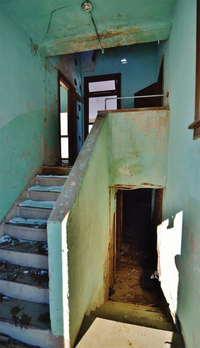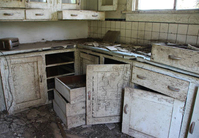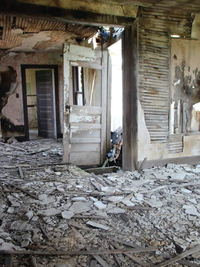As a teenager living in Bon Homme County, I must have driven past this old metal building with the broken letters spelling out Perkins on the front of it, at least a dozen times and never once thought what it might be or what it represented. Even as an adult living in Tyndall, SD nearly twenty five years now, not till 2015 did I even know that at one time there was a community named Perkins that sat just a few miles west of Springfield, SD. My husband being the researcher of plotting and searching for new locations for us to photograph, had come across information for Perkins and planned our destination one Saturday afternoon.
On the north side of the road sits a very uniquely designed metal building; we walked completely around the outside amazed at the size of this structure and the beautiful condition it was still in. Looking through every window we saw it was filled to the brim with old vehicles, bicycles and item too numerous to mention. Across the road we crossed over a down fence line overgrown with weeds and ditch grass, still somewhat standing in the distance was a home that Mother Nature and time had taken its toll on. This family home, I’m sure at one time was a beautiful home for the time period it was built. Mostly broken floorboards, pealing wallpaper remnant and kitchen cupboards and drawers and a lone toaster was all that remained inside the old home. A few small out buildings and what looked to be a store of some sort, but with most of the walls and roof collapsed and being taken over by the growth of vegetation, it was hard to tell what it once was. Just around the corner to the next gravel road sat another home completely intact and the Perkins church all fenced off with “No Trespassing” signs. This is all that remains for the village of Perkins, SD.
About a year later an old friend of ours, Jeff Staples had reached out to us that his dad owned the section of land that a house and the Perkins church sat on and we were welcomed to come
photograph it as they were cleaning out the abandoned home and cutting down trees and clearing out all the over growth of vegetation on the property.
Ryan and I were elated and of course took him up on his offer. We met Jeff and his dad at the church and as we walked through the church we listened to them tell us the history of the church and why they had to put up the “No Trespassing “signs as his dad was working to get the church put on the National Register of Historic Places and had had vandals throw rocks breaking out some of the windows. This I will never understand as even in my youth did I nor my friends find enjoyment in being destructive to property even old or abandoned structures as a form of entertainment. Even now for Ryan and I and many other photographers throughout our country who tour and photograph abandoned locations there is a code and you adhere to it.
We don’t damage anything, we don’t break into buildings, we never remove items and we never deface a location. We’re there to preserve a record of the unseen history decomposing before our eyes. Capturing the spaces humans leave behind. Jeff’s dad explained what it would take to accomplish getting what needed to be done to the church to make the National Register of Historic
Places. And just recently they made this happen.
According to the South Dakota State Historical Society, the Perkins Congregational Church near Springfield was recently added to the National Register of Historic Places.
The Perkins Congregational Church Society was organized in 1900 and completed construction of their building in 1901. It was formed by settlers of mixed ethnicities including English, German, Scandinavian (Danish), and Dutch. Located at 31205 409th St., it is listed in the National Register as significant locally for architecture. The building represents early churches constructed in the late Gothic Revival style in Bon Homme County. The church has a wood frame, clapboard siding, lancet-arch wood windows, and a central steeple entrance. The Perkins church was “yoked” to the larger Congregational church in Springfield. Both churches were part of a circuit with the Congregational churches at Springfield, Perkins, Tyndall, Running Water, Leyden, and Kingsburg in various combinations over the years. In 1904, Bon Homme County had eleven established Congregational church societies, including the Perkins congregation. The frame church was the first and only church built in the hamlet of Perkins. In the year 1904 a small church was organized west of Perkins in what was known as the Dahlenburg School, under the name of Lyden church, a name given by Mrs. Woudsma’s husband, after a town in his native country, Holland. Mrs. Woudsma was a charter member of the Lyden Ladies Aid and later joined the church when it was reorganized as the Perkins Lyden Congregational church and was an active worker in the group.
In 1923, the Leyden congregation merged with Perkins, changing the name of the church to the Perkins Leyden Congregational Church. By 1942, the small Perkins Leyden congregation had disbanded, and the Congregational Church Building Association sold the Perkins Leyden Church building and its property to the Bethlehem Norwegian Evangelical Lutheran congregation, which disbanded in 1968.
The history of the village of Perkins began in 1897, when Captain Leach of Running Water purchased three acres of land from Fred Perkins. Leach opened The Peoples Store, which contained a post office, cooperative creamery, and feed store. Perkins later also included a school, Modern Woodmen of America Hall, machine shop, pool hall, creamery and a blacksmith shop. The development of better roads and larger stores in nearby communities led to local farmers shopping out of town, causing the decline of the village.
After our tour of the church Jeff walked us over to the abandoned home still standing and full of belongings, not having been lived in for some time the cobwebs were thick and in the kitchen where the sink was, it was filled with dishes and silverware and the cobwebs blanketed even encasing the items creating a mummified look. Each time I enter an abandoned home that still has almost all the belongings still present from furniture to photos, Knick-knacks, toys, clothes, so many personal items the same questions always come back to me. Why would anyone leave everything they have behind? And what happened to the person or family that once lived here? It can be a earie feeling when I enter and start to look around, but in each instance I always focus on what I need to capture to document where we’ve been and these abandoned locations before they are completely gone and in hopes of telling a story for others to enjoy and even for future generation to see.
Think of all the memories that make up your life story: secrets shared with siblings; back yard barbeques; family vacations; your first car, first date, first kiss; building a career or a business; saving for that first home; raising children of your own….the list goes on and on. Preserving those stories can be a tremendous gift for future generations that helps bring richness and depth to your family’s history. What better way is there to celebrate life than to capture the story of how we got here?






